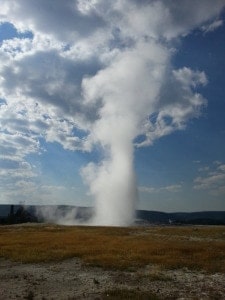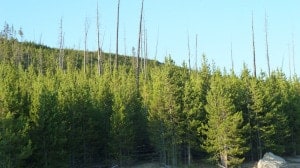Yellowstone National Park
We entered Yellowstone through their north entrance. The first thing that we saw was steam coming up from the puddles on the side of the road. That was an interesting introduction to the park. The two major attractions of the park outside of the lovely scenery are probably the wildlife and the geo-thermal features. Wildlife is everywhere. At the beginning you stop the car to take a picture every time you see a bison no matter how far away it is. After four days you don’t even stop for bison on the road right next to you unless there is something unique about it. According to Yellowstone bison and buffalo are just two different names for the same animal. In additional to the bison we had deer wandering around our campgrounds. Supposedly there where bears wandering around the campground as well but we didn’t see any. We saw a couple of bald eagles but not really close-up. There were also elk (in parking lots), pronghorn which look like antelope to the uninitiated and more. I am working on creating a photo gallery to link to from this website. There will be more pictures of wildlife there.
 The roads in Yellowstone are very slow to drive and when the bison decide that they want to walk down the middle of the road traffic is basically halted. I was reminded of Mike’s and my arrival in New Delhi, India where the oxen wandered down the road as you left the airport. It was very handy having the car in Yellowstone to tour around in every day while the RV stayed parked and setup in the campground. Parking was obviously much easier with the car. I will admit that there were times when it would have been nice to have the RV with us just to take a break in or to make a coffee (or to have a washroom available!). We didn’t get in any bike riding in Yellowstone but we did a fair bit of walking on trails that were setup up for tourists.
The roads in Yellowstone are very slow to drive and when the bison decide that they want to walk down the middle of the road traffic is basically halted. I was reminded of Mike’s and my arrival in New Delhi, India where the oxen wandered down the road as you left the airport. It was very handy having the car in Yellowstone to tour around in every day while the RV stayed parked and setup in the campground. Parking was obviously much easier with the car. I will admit that there were times when it would have been nice to have the RV with us just to take a break in or to make a coffee (or to have a washroom available!). We didn’t get in any bike riding in Yellowstone but we did a fair bit of walking on trails that were setup up for tourists.
There are five types of geothermal features in Yellowstone. Steam vents (fumaroles), geysers, hot springs, mud pots, and something called travertine terraces. It is very interesting to see the steam all over the place and mud puddles bubbling away. Although the mud puddles look like they are boiling it is really gas escaping from the earth below. The Old Faithful geyser is famous not because it is the biggest geyser in the park but because it is the most predictable. It erupts roughly every 60 – 90 minutes. The time between eruptions is based on how long the previous eruption lasted. I believe that there is a webcam on Old Faithful all the time. As I said in an earlier article Mike was impressed that someone could take ground that appears to be the site of a major environmental disaster and turn it into a huge tourist attraction. When the steam and water come up from the ground all sorts of minerals and things that smell such as sulphur come along for the ride. The park has done a super job of building walks around the major areas of mud pots and geysers and hot springs. Because the areas within the boardwalks are so different than anything you have seen previously and because they are such a huge tourist attraction you almost don’t realize how bad they really do look. The ground temperature gets to about 200 degrees F (93 C). The ground temperature in any given area changes over time. You can see this when you look at the trees in the centre of some of these areas. They are full grown upright trees that are completely dead. Their roots must have burned after they were grown which means that the ground temperature around them must have changed.
 On one walk past dozens of geysers we saw a one erupting. It wasn’t huge but it was spewing water probably 12 feet into the air. When we got back to the entrance we mentioned to some other tourists that we had seen what I thought was the Steamboat Geyser erupting. Each of the many geysers has a name on a plaque in front of it. A park ranger overheard and said “You saw the Steamboat Geyser erupting!” and before I could explain what we had seen the ranger was racing off at full speed somewhere. None of us had a clue what I had said or why it caused such a major concern. At that point I told Mike that it was time for us to leave. I didn’t want to be there when the ranger came back. I was pretty sure that I had said something wrong but I didn’t know what. Later on we found out that the Steamboat Geyser had had a major eruption about 2 weeks earlier. I had the wrong name. The rangers were probably afraid that it would erupt again. Last time the eruption occurred it was about 11pm at night with no-one around. Large amounts of boiling water had flowed down the ground and across the boardwalk. I assume that people would have been badly burned if they had been there at the time. That has happened before at Yellowstone. There is no real time monitoring of these geysers. Data needs to be collected from near the geysers themselves. It is possible that the rangers closed that area of the park while they were checking out the story they had heard. I did feel rather bad.
On one walk past dozens of geysers we saw a one erupting. It wasn’t huge but it was spewing water probably 12 feet into the air. When we got back to the entrance we mentioned to some other tourists that we had seen what I thought was the Steamboat Geyser erupting. Each of the many geysers has a name on a plaque in front of it. A park ranger overheard and said “You saw the Steamboat Geyser erupting!” and before I could explain what we had seen the ranger was racing off at full speed somewhere. None of us had a clue what I had said or why it caused such a major concern. At that point I told Mike that it was time for us to leave. I didn’t want to be there when the ranger came back. I was pretty sure that I had said something wrong but I didn’t know what. Later on we found out that the Steamboat Geyser had had a major eruption about 2 weeks earlier. I had the wrong name. The rangers were probably afraid that it would erupt again. Last time the eruption occurred it was about 11pm at night with no-one around. Large amounts of boiling water had flowed down the ground and across the boardwalk. I assume that people would have been badly burned if they had been there at the time. That has happened before at Yellowstone. There is no real time monitoring of these geysers. Data needs to be collected from near the geysers themselves. It is possible that the rangers closed that area of the park while they were checking out the story they had heard. I did feel rather bad.
 Another common sight are forests of pine trees with much taller dead trees sticking up above the live trees. The majority of the trees are lodgepole pines. In the past the fire rangers worked really hard to stop any forest fires from getting out of control. In the 1980s they decided that fire was actually good for the regeneration of forests and that they would let nature take her course within the forest areas. This was good in theory but because the forest hadn’t been allowed to burn for many years when they had a big fire in 1988 it burned an extremely large area. The cones of the lodgepole pine require the heat of a forest fire to open and release their seeds. As you can see in the picture the live pines are now about 25 years old and look good and healthy but are nowhere near the height yet of the old forest.
Another common sight are forests of pine trees with much taller dead trees sticking up above the live trees. The majority of the trees are lodgepole pines. In the past the fire rangers worked really hard to stop any forest fires from getting out of control. In the 1980s they decided that fire was actually good for the regeneration of forests and that they would let nature take her course within the forest areas. This was good in theory but because the forest hadn’t been allowed to burn for many years when they had a big fire in 1988 it burned an extremely large area. The cones of the lodgepole pine require the heat of a forest fire to open and release their seeds. As you can see in the picture the live pines are now about 25 years old and look good and healthy but are nowhere near the height yet of the old forest.
After Yellowstone we drove through Grand Teton National Park which adjoins Yellowstone on the South. We had lunch at a resort with a gorgeous view of the Tetons mountain range. The picture at the top was actually taken from this resort. We are now leaving the parks for a few days and heading south.


Leave a Reply